Metal spinning, also known as spin forming, is a precision metalworking process where flat or hollow billets are mounted onto a spinning machine's mold. As the billet rotates, a spinning wheel or driving rod applies controlled pressure, inducing localized plastic deformation to shape the material.
At Yixing Technology, we elevate this process by combining the principles of forging, extrusion, stretching, and bending into a seamless operation. Our advanced techniques minimize or eliminate the need for cutting, ensuring efficient material usage and superior surface finishes. By pressing metal billets—whether cylindrical, flat, or preformed—onto a rotating core mold, we achieve continuous, point-by-point deformation, producing high-precision hollow rotating parts with complex geometries.
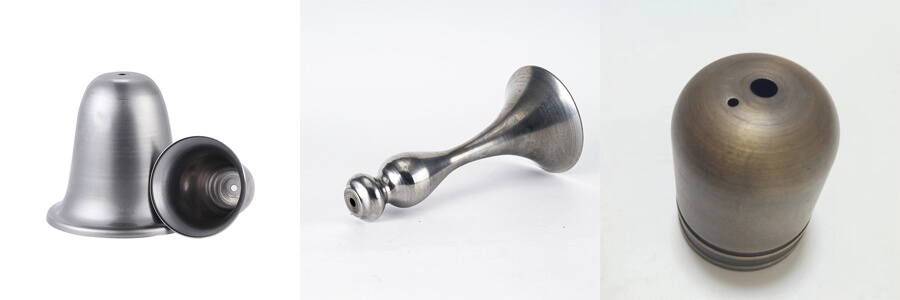
Ideal for conical components used in:
Aerospace: Engine cones, nose cones, and aerodynamic fairings.
Automotive: Exhaust components, air intake cones, and suspension parts.
Lighting: Reflectors, lamp shades, and conical light fixtures.
HVAC: Ducting components and conical diffusers.
Defense: Missile casings and radar housings.
Perfect for manufacturing:
Ball Valves: High-precision spherical components for fluid control systems.
Decorative Elements: Architectural domes, ornamental spheres, and artistic installations.
Lighting: Spherical lamp covers, pendant lights, and decorative lighting fixtures.
Medical Equipment: Spherical housings for imaging devices and surgical instruments.
Energy Sector: Pressure vessels and storage tanks.
Consumer Goods: Cookware lids and spherical containers.
Essential for creating cylindrical parts in:
Machinery: Hydraulic cylinders, rollers, and bearing housings.
Instrumentation: Sensor housings, telescope tubes, and laboratory equipment.
Automotive: Fuel tanks, exhaust pipes, and shock absorber tubes.
Aerospace: Rocket bodies, satellite casings, and engine housings.
Lighting: Cylindrical lamp bodies, housings for LED fixtures, and industrial light tubes.
Industrial Equipment: Compressed air tanks and pneumatic cylinders.
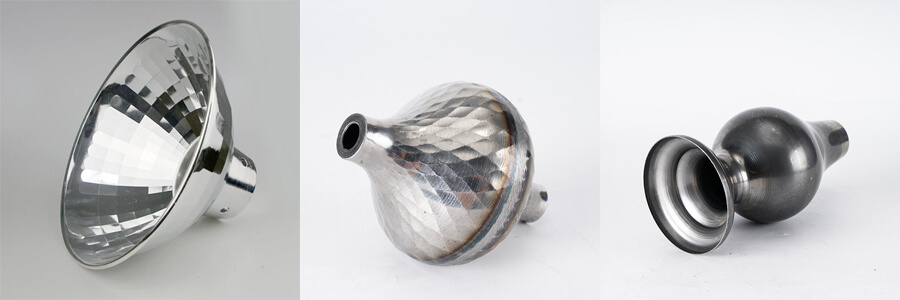
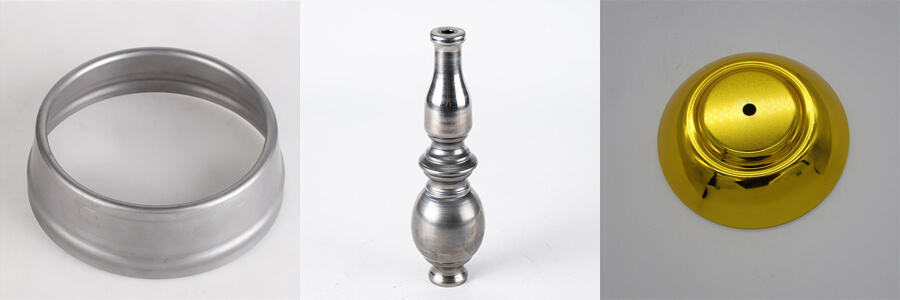
Yixing Technology delivers precision metal spinning services that cater to a wide range of industries, including lighting, aerospace, automotive, nuclear power, and electronics. Our advanced spin forming technology enables the production of high-quality, complex components with exceptional accuracy and efficiency.
Automotive: Car wheels, exhaust diffusers, oxygen sensor housings, and other critical components.
Aerospace: High-precision parts such as aircraft engine turbine blowers, rocket engine turbine pumps, and aerodynamic fairings.
Lighting: LED reflectors, lamp cups, lampshades, downlights, and other lighting components.
Electronics: Housings for sensors, connectors, and other precision parts.
Nuclear Power: Radiation shielding components and specialized containers.
Our metal spinning services are versatile and adaptable, making them ideal for diverse sectors, including:
Lighting Industry Sculpture and Ornamental Cryogenic Industry
HVAC Industry Craft Brewing Industry Agricultural Industry
Transportation Industry Oil & Gas Food Industry
Marine Industry Bulk Handling Medical/Pharmaceutical
Aerospace Automotive Electronics Industry
At Yixing Technology, we combine cutting-edge technology with expert craftsmanship to provide tailored solutions for your unique needs. Whether you require high-volume production or custom prototypes, we are committed to delivering precision and quality in every project.
Contact us today to learn how our metal spinning and spin forming expertise can elevate your next project!
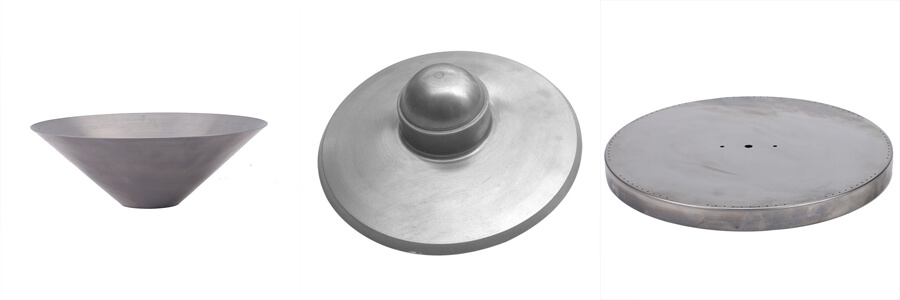
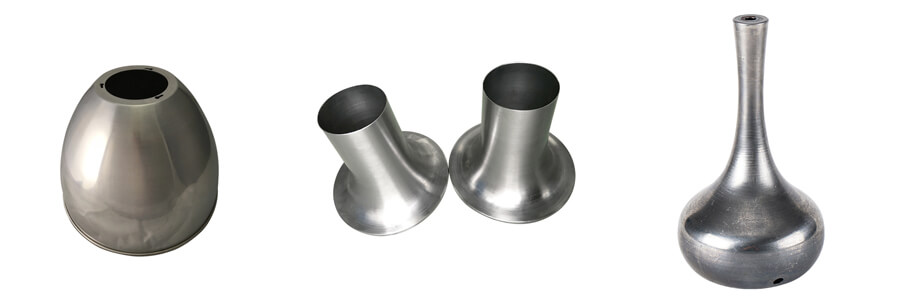
Discover the precision and versatility of Yixing Technology's Custom Metal Spinning Service through our production showcase. From intricate lighting components to high-performance aerospace parts, our advanced spin forming technology brings your designs to life with unmatched accuracy and quality. Explore how we transform raw materials into flawless, custom-made products for industries like automotive, electronics, and more.

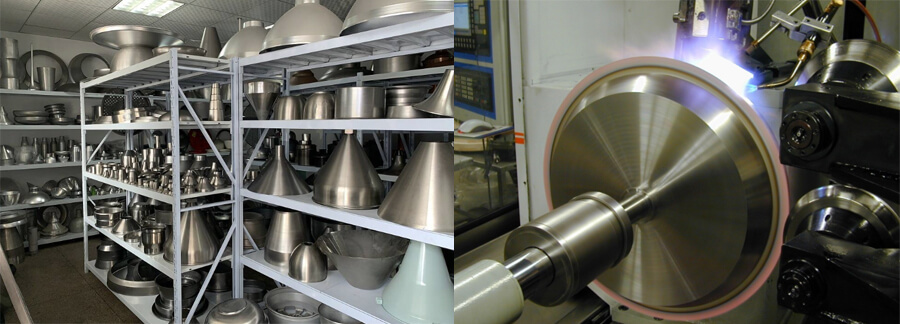
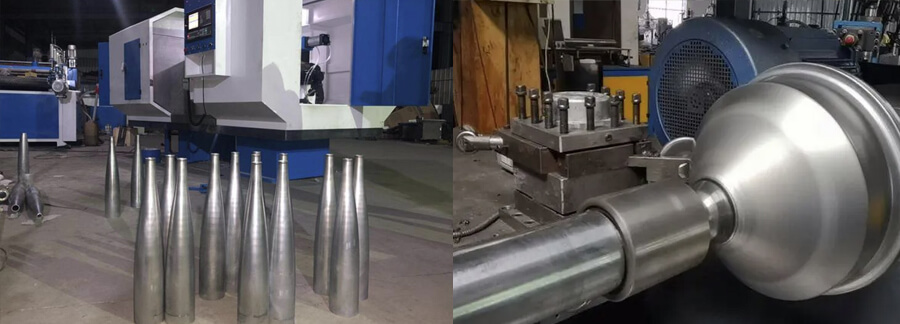
Yixing Technology specializes in both CNC metal spinning and manual spinning, offering versatile solutions for a wide range of metal forming needs. With advanced CNC technology, Yixing Technology ensures high precision, consistency, and the ability to handle thicker materials efficiently. At the same time, our expertise in manual spinning allows for flexibility in crafting custom or intricate designs, particularly for smaller-scale or specialized projects. This dual capability enables Yixing to cater to diverse customer requirements, combining the efficiency of modern machinery with the artistry of traditional craftsmanship.
Control Method: CNC metal spinning uses a numerical control system to accurately control the path of the cutter wheel and the gap between the cutter wheel and the mold. Manual metal spinning completely relies on manual control of the cutter bar to determine the path of the cutter wheel. The path and gap between different products will be different, and are greatly affected by human factors.
Processing Accuracy: CNC metal spinning equipment offers high precision, rigidity, and processing power, ensuring consistent product accuracy, whereas manual metal spinning struggles with unstable precision. Manual metal spinning is limited by human strength, making it difficult to process thicker materials like iron over 1.2mm, aluminum over 1.5mm, or stainless steel over 1mm, often leading to defects. CNC metal spinning, however, overcomes these limitations and handles thicker materials efficiently.
Product Consistency: CNC metal spinning parts have better consistency. Due to differences in manual operation, there are certain differences between each product in manual spinning, so the consistency of batch products is poor.
Production Efficiency: CNC metal spinning can realize automated production and has high production efficiency, while manual metal spinning has lower production efficiency.
At Yixing Technology, we specialize in spin forming for a wide range of materials, from easy-to-spin aluminum to challenging titanium alloys. Our advanced equipment and expertise ensure high precision and efficiency, even for the most demanding projects.
Contact us today to learn how we can meet your custom metal spinning needs with the right materials and cutting-edge technology!
| Aluminum spinning | Copper spinning |
| Brass spinning | Steel spinning |
| Stainless steel spinning | Special alloy spinning |
| Material | Grade | Property | Spin Forming Performance | Application |
| Aluminum | 1050 1060 1070 1100 etc | Excellent ductility; spinning performance varies with heat treatment state (soft, semi-hard, hard). Soft state (O state) is ideal for spinning. Performance decreases from 1000 to 6000 series under the same heat treatment. | Low hardness, excellent spinning performance. | Lighting, Home Appliances, HVAC |
| 3003 etc | Good tensile strength, moderate ductility. | Suitable for hydraulic stretching and forming. | Hydraulic Components | |
| 5052 5251 etc | Requires heat treatment to O state for optimal spinning. | Moderate spinning performance; pre-treatment improves formability. | Automotive Parts | |
| 6061 6063 etc | Lower ductility compared to 1000 series. | Challenging to spin; requires precise control. | Construction, Structural Components | |
| Copper | T1 T2 TU0 TU1 etc | Excellent ductility; easy to form. Brass has lower ductility and higher rebound. | Copper spins well; brass is more difficult due to poor ductility and rebound. | Crafts, Military Applications |
| Steel | SPCC DC04 Q235 etc | Moderate hardness and ductility; spins better than stainless steel but harder than aluminum. | Easy to spin with standard equipment. | Industrial Equipment, Lighting |
| Stainless Steel | 201 304 316 etc | High tensile strength and hardness; poor ductility. | Difficult to spin; requires high-power equipment and precise control. | Industrial Equipment, Tableware |
| Titanium | Exceptional tensile strength but poor ductility; harder to form than stainless steel. | Extremely challenging to spin; requires specialized equipment and techniques. | Aerospace, Military, Tableware |
Low Mold Cost: Compared with die casting and stamping, metal spinning usually only requires simple core molds and spinning wheels and other tools, so the mold cost is low. Suitable for low volume production.
Superior Strength: During the spinning process, the metal material undergoes continuous plastic deformation. The metal grains are refined and arranged in a specific direction to form a fibrous structure so the strength and hardness of the metal spun product is improved.
Ideal for Axisymmetric Parts: Metal spinning is best for cylindrical, conical, hemispherical, parabolic, etc designs which cannot be realized through other methods economically.
Seamless Design: Since the metal spinning parts are seamless without welding joints and points, it can stand higher pressure internally and externally.
Dominique Vinci(France)
We have received the samples and confirm that they have been qualified. They successfully passed all our inspections.
Petr Hein (Czech Republic)
Good job, thank you. We agree with the adjustments you made. We approve the samples. Today I will send a request for paying the remaining 19800 USD. Please start to plan your production, you will get your money within a few days, and I will send you the bank payment confirmation after we pay it.
James Irvine (Australian)
Those test samples came and we have tested them.They are perfect! They worked excellent! We need to complete the immediate order of 20,000 ASAP. Can you get that under way immediately?
Thank you!!
I will check 6mm Cup drawing tonight and initiate that over the coming days.
Markus Kalmbach (Germany)
Thank you very much for your patience! We are just proceeding the last tests and right now we are really happy with the quality. Some minor things where we need to talk about, but we are convinced that your company is able to deliver the quality we nee. We would like to extend our cooperation with you.

Expert Metal Forming Solutions: Yixing Technology is a professional sheet metal forming manufacturer engaged in CNC metal spinning parts, stamping parts and deep drawing parts with high cost-effectiveness, high precision, and high stability.

Tailored Metal Spinning Services:Yixing Technology provides custom metal spinning services, which can customize various special-shaped metal spinning parts according to customer drawings. The material we can spin includes copper, brass, aluminum, steel, stainless steel. The diameter of the metal spun part can range up to 1500mm. The thickness of the metal spun part ranges from 0.5 to 10mm.

Versatile Applications and Finishes: Yixing Technology makes various copper lamp shell, floor lamp panel, lamp cup, pot, elliptical heads, tank heads, funnels, hoppers, bowls, fan panels, bell mouth Fittings, etc by metal spinning. Surface treatment like powder coating, anodization, plating, polishing etc can also be applied on the metal spun parts per customers' requirements.

1. Fix the cut circular metal plate onto the machine core rod.
2. The core rod drives the circular metal sheet to rotate at high speed, and the tool with a rotating wheel begins to press the metal surface until the metal sheet fully fits into the inner wall of the mold and is formed.
3. After the molding is completed, the core rod is taken out, and the top and bottom of the part are cut off for demolding.
Both spin forming/metal spinning and deep drawing can shape the sheet metal, with specific differences and advantages as follows:
1. Principle difference:
Spin forming is controlled by the path of the cutting wheel to control the flow and deformation of the sheet metal, while the deep drawing controls the flow of the sheet metal through the combination of convex and concave molds.
2. Mold cost difference:
The deep drawing mold cost is usually 3-6 times that of metal spinning, and the manufacturing cycle of metal spinning molds is also shorter. For low volume parts, metal spinning is usually much more cost effective.
3. Material difference:
The thinning rate of metal spinning is usually about 30%, while that of deep drawing is about 10%. Deep drawing requires about 5-10mm of edge pressing material, which requires a higher material cost.
4. Production speed:
With deep drawing or stamping mold, the production speed is much faster than metal spinning. Metal spinning’ speed for one part is relatively slow so it is ideal for short run projects.
5. Surface difference:
In terms of the surface, the spinning marks are distributed in a circular pattern, while the stretching marks are distributed in a vertical line; In terms of strength, the strength of spun products is much better than that of stamping.
Yixing Technology is a sheet metal fabricator who has strong capability to do metal spinning and deep drawing/stamping both. If you are not sure what process is best for your projects, please send us your designs, order volume, application etc, we can suggest the metal spinning or other metal forming process for the most economical cost.
In short, ordinary metal spinning emphasizes concave shapes, while strong metal spinning emphasizes thinning and lengthening.
Ordinary metal spinning is a spin forming process that mainly changes the shape of the billet, with the wall thickness basically unchanged or less changed. Ordinary metal spinning mainly shapes workpieces by changing the diameter size of the sheet metal. It is a non cutting forming process for processing thin-walled rotating bodies, which is formed by spinning the rotating metal circular plate or preform through feed motion of the spinning wheel.
Metal spinning, while versatile and effective for many applications, does have certain limitations. Here are some key constraints:
1.Harder materials, such as high-strength steels or titanium, are more difficult to spin and may require specialized equipment or pre-treatment.
2. While metal spinning is excellent for producing axisymmetric parts (e.g., cones, cylinders), it is less suitable for highly complex or asymmetrical designs.
Features like sharp corners, undercuts, or intricate details may be challenging to achieve.
3. Manual metal spinning is labor-intensive and time-consuming, making it less efficient for large-scale production.
CNC metal spinning is faster but may still be slower than other mass-production methods like stamping or deep drawing.